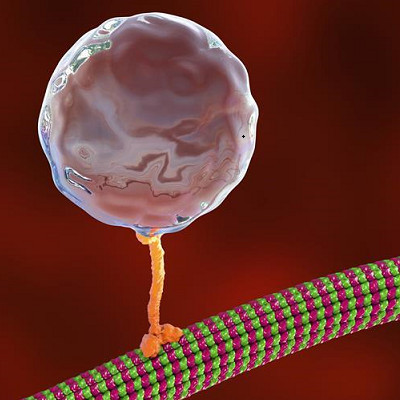
2021-02-19
Visited : 1626
Tübingen researchers develop force microscopes for the nanoscale - The motor protein kinesin makes tippy-toe steps and slips
Motor proteins generate the forces for essential mechanical processes in our body. On a scale of nanometers - a millionth of a millimeter - motor proteins, for example, power our muscles or transport material within our cells. Such movements, invisible to the naked eye, can be made visible by Erik Schäffer: the professor of Cellular Nanoscience at the University of Tübingen develops special force microscopes, so-called optical tweezers, to measure how these molecular machines work mechanically. His team at the Center for Plant Molecular Biology has now improved the technology. Special probes, germanium nanospheres, enable a higher resolution of displacements and forces that the motors generate. The results have been published in the journal Science.
With a size of just 60 nanometers, the motor proteins studied are truly tiny, but essential for cellular processes. Among other things, they help to mechanically pull apart chromosomes during cell division, or they transport small "packages", so-called vesicles, within cells. Dysfunctional motors, for example in nerve cells, may lead to neurological diseases such as Alzheimer's.
To unravel how motor proteins work, biophysicist Erik Schäffer developed ultra-precise optical tweezers. They are based on principles already discovered by astronomer Johannes Kepler in 1609. For their invention, the physicist Arthur Ashkin received the Nobel Prize in 2018. The optical tweezers exploit the radiation pressure of laser light to contactless hold tiny particles in place. Using this tool, Schäffer has been able to demonstrate a few years ago that the motor protein kinesin rotates while walking: with two “feet,” it takes eigth nanometer large steps making a half-turn each time - almost as if performing a Viennese waltz.
Schäffer’s PhD student Swathi Sudhakar has now refined the optical tweezers technology further. Using germanium nanospheres, much smaller and higher-resolution probes, one can still counteract the unimaginably tiny, five-piconewton forces of the biological motors. This means the researchers can now measure even the smallest and fastest movements that were so far hidden in the storm of the jerky thermal motion inherent to small particles.
With the new technology, the researchers could track kinesin in real time, and Sudhakar detected another intermediate step in its locomotion, making the waltz almost perfect. “Whether this intermediate step exists has been debated among scientists for 20 years,” Schäffer says. “We were able to measure this directly for the first time using optical tweezers.” In addition, the nanospheres revealed a previously unknown slip mechanism of the motor. “It is a kind of safety leash that keeps the motor on track if the load is too high,” says Schäffer. This mechanism explains the high efficiency of vesicle transport in cells, he adds. “If we know how kinesin motors work in detail, we can also better understand the vital cell processes that the motors power, as well as malfunctions that can lead to disease.”
Schäffer compares the new technology with “taking a good look under the hood” of molecular machines. He says that now, researchers can not only precisely observe individual movements of molecular machines; they can also better understand, for example, how proteins fold into their correct structure. “As semiconductors, the nanospheres have additional exciting optical and electrical properties. Therefore, they could be useful in other areas of nanoscience and materials science, for example, for better lithium-ion batteries,” Schäffer says.
Read the original article on University of Tübingen.